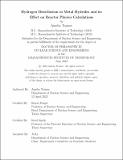Hydrogen Distribution in Metal Hydrides and its Effect on Reactor Physics Calculations
Author(s)
Trainer, Amelia
DownloadThesis PDF (16.16Mb)
Advisor
Forget, Benoit
Smith, Kord
Terms of use
Metadata
Show full item recordAbstract
Efficient and trustworthy simulations of nuclear reactor systems require that neutronmaterial interaction data be accurate, convenient to use, and readily available. When describing these interactions, the corresponding data is highly dependent on factors such as neutron energy, material temperature, and material composition. This work focuses on the scattering behavior of thermal neutrons, which are defined to have relatively low energy (typically less than 1-10 eV). Thermal neutrons are particularly interesting since, unlike their higher-energy counterparts, they are unable to ignore the molecular bonds that hold a target atom in place. While higher-energy neutrons interact at speeds sufficiently high such that they can disregard these bonds, thermal neutrons are unable to make such an assumption. When scattering, thermal neutrons may interact with the vibrational, rotational, and translational modes of a material, thus causing the interaction data to not only be specific to the target atom, but also to the material in which the atom resides. In this work, the role of vibrational excitation and de-excitation in thermal neutron scattering is explored, as it pertains to metal hydrides. Exciting and de-exciting vibrations corresponds to energy change, where a neutron may deposit energy into the material, thus inciting a vibration (phonon), or gain energy by destroying a phonon. This change in energy specifies inelastic scattering.
In order to prepare inelastic thermal neutron scattering data, the phonon distribution of the target material must be known. The phonon distributions of commonly-used moderators are often published in nuclear data libraries. However, they utilize many assumptions. For instance, these phonon distributions are often assumed to be independent of temperature and, for metal hydrides, independent of stoichiometric variation. The goal of this work is to generate phonon distributions that account for both of these variables (temperature and composition), and to illustrate the effect they have on reactor calculations. The material of interest for this study is zirconium hydride which, despite its variable hydrogen concentration, is commonly described using a phonon distribution that corresponds to a single temperature and a single hydrogen concentration. Approximating a range of different hydrogen concentrations and temperatures by a single distribution has not yet been sufficiently verified as an acceptable assumption. Phonon distributions corresponding to various material temperatures and hydrogen concentrations are generated via density functional theory and molecular dynamics, and their effects are tested in a series of reactor calculations.
Thermal scattering data often involves storing notoriously large files and, therefore, accounting for different material compositions can bring an overwhelming burden through storage requirements. To address this limitation, the “phonon sampling method” is developed, which allows for thermal scattering data to be represented using < 1% of the storage that existing methods require, while resulting in a minor but noticeable increase in calculation time.
Through using the hydrogen- and temperature-dependent ZrHₓ phonon distributions developed in this study, alongside the phonon sampling method, alterations to the overall shape of the phonon distributions are shown to noticeably affect reactor behavior, including the multiplication factor 𝑘 and flux distributions.
Date issued
2023-06Department
Massachusetts Institute of Technology. Department of Nuclear Science and EngineeringPublisher
Massachusetts Institute of Technology